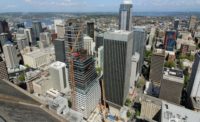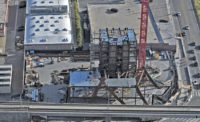City Creek's Retractable Skylight and Creek Replica Survive Temblor

Centerpiece of City Creek Center in Salt Lake City apparently survived the recent magnitude-5.7 quake unscathed.
Photo by Michael Dickter/MKA
There is no apparent damage from March 18th's magnitude 5.7 earthquake near Salt Lake City to City Creek Center's two-block-long retractable skylight or to the creek replica flowing beneath it, according to sources. The shopping district opened eight years ago.
“At this time no visible damage has been reported to UNI,” says Mark Silvera, president of Uni-Systems Engineering, which supplied the skylight. “Our customer has asked us for recommendations on post-earthquake inspections prior to moving the system and we are recommending it be inspected by a qualified person prior to commencing normal operations,” he adds.
Shelley R. Clark, the senior principal for the development’s structural engineer, Magnusson Klemencic Associates, says, “it looks like there is no damage,” at least that is known, to City Creek’s structure.
City Creek’s retractable skylight and the 1,225-ft-long replica of its namesake are the centerpieces of the retail district. The district is part of a 5.5-million-sq-ft urban infill project developed by the Church of Jesus Christ of the Latter Day Saints.
The skylight was the project's most intricate element. But the faux creek that runs under it, designed by the San Francisco office of landscape architect SWA Group, ranks as a close second because it is built on top of the project's seismic superdecks, like a green roof at grade.
City Creek spans more than two, 660-ft-square megablocks. The blocks, called 75 and 76, are separated by Main Street. Each has a steel-framed superdeck that transfers loads from different column grids of a steel retail-and-residential podium above to a 50- or 60-ft-deep structural concrete basement.
The skylight system, which has a complicating curve, consists of two independent 58-ft-wide sections, one 230 ft long and the other 240 ft. The sections are separated by Main Street, which bisects the two-megablock City Creek. The sections curve in opposite directions to follow the concourse's serpentine curve.
Each section consists of three opposing glass-covered arched panels that each cantilever 29 ft from the roofs of four-story row buildings facing each other across the 55.5-ft-wide concourse. Each panel has three main arched structural steel members—fabricated plate box "ribs" dubbed whalebones because of their shape, with a 12.5-ft upturned backspan, or tail.
The backspan of each 10.5-ton whalebone rides on a main wheel at the front of the tail, powered by an electric motor, and a set of uplift rollers at the tail's end.
The wheel rails are on a rail girder, which bears on two stanchions that transfer loads into the structure below. The rail girder also ramps up at the back.
In 2012, Mark Silvera was named an ENR Newsmaker for Uni-System’s work on the novel skylight.



